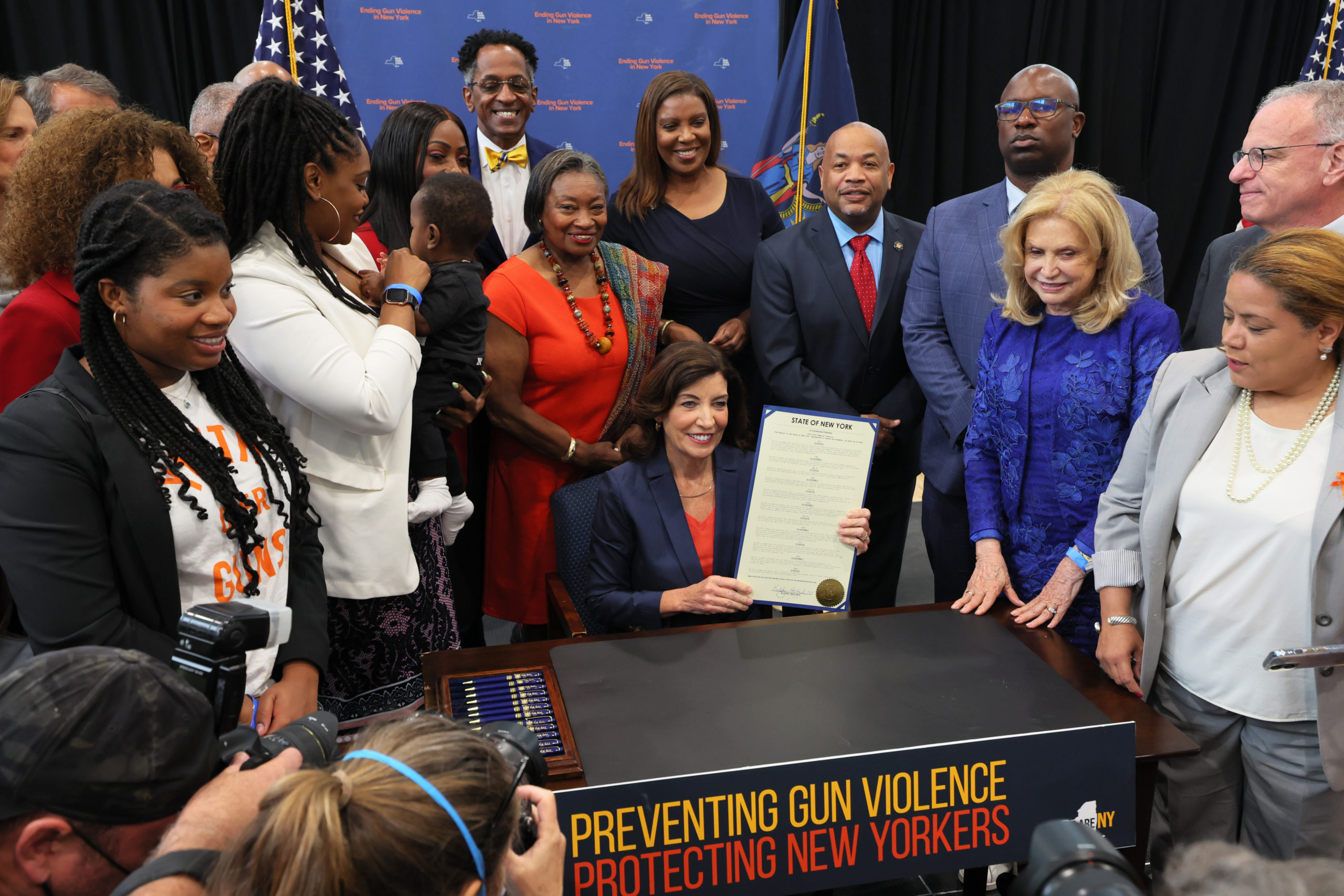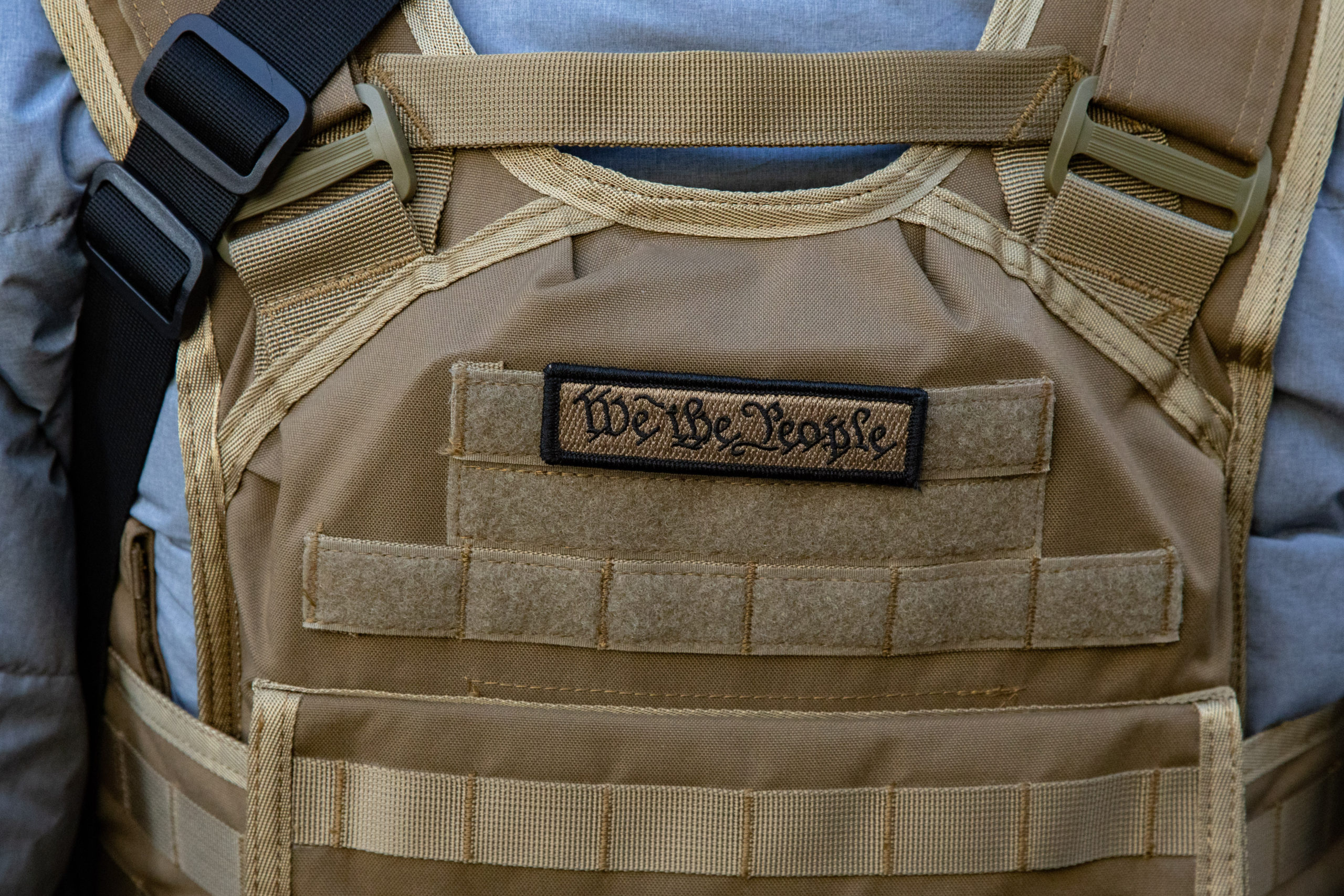On June 6, New York Governor Kathy Hochul signed into law a package of gun reforms that includes expanding the state’s red flag law, raising the legal age to buy semiautomatic rifles and requiring a license, and banning the sale of body armor to civilians. The legislation came three weeks after a teenager wearing body armor killed 10 people at a Buffalo supermarket. The body armor deflected a security guard’s bullets and allowed the gunman to continue his rampage.
But the new law doesn’t prohibit the type of body armor worn by the gunman, Hochul’s office confirmed to The Trace. The words “body armor” don’t even appear anywhere in the bill, even though it’s been described as a “body armor” ban by Hochul and state lawmakers in news releases.
According to law enforcement, the 18-year-old gunman wore what’s known as a plate carrier: a vest, often made of ordinary fabric, that holds hard armor plates designed to protect against rifle rounds. The legislation signed by Hochul bans the purchase of “body vests,” which are defined in state law as “a bullet-resistant soft body armor.” Soft body armor is flexible, more concealable, and designed to stop small-caliber rounds.
Hochul’s office confirmed that the ban does not expressly cover hard body armor, and sent us a statement saying that “she would fully support additional measures to strengthen the laws further if passed by the legislature.”
Assemblymember Sarah Clark, an upstate lawmaker, also conceded that the new law doesn’t cover hard plates. She explained that because plate carriers can be made of bulletproof materials, the law would by extension “capture scenarios like we saw with the Buffalo gunman.” However, many plate carriers are made of materials like nylon, and would not be banned. “I think we will have to wait for the final regulations to come out to see how this is truly implemented,” Clark added.
The law is so confusing that not even its chief sponsor seemed to understand the gap in the measure. Assemblymember Jonathan Jacobson told The Trace he believed it covered hard armor: “That’s my understanding.” Jacobson said that if the body armor ban “is somehow interpreted” to exclude hard body armor, “we’re coming back in January, so we’ll amend it.”

Beau of the Fifth Column, a journalist and YouTube personality, was among the first to flag the confusing wording of the ban. “Modern body armor isn’t soft. It’s a hard plate,” he said in a recent video. Without a legislative fix, the law is a “feel-good measure” that’s ultimately ineffective, he said.
The ban wasn’t devised in the aftermath of the Buffalo shooting. Jacobson first introduced a version of it in 2019, but it stalled. The legislative session ended 19 days after the Buffalo shooting, so the timing suggests that the law was revived, but not necessarily tailored to the moment. That’s evident in the state’s definition of “body vest,” which hasn’t been updated in years: soft armor “providing, as a minimum standard, the level of protection known as threat level I which shall mean at least seven layers of bullet-resistant material.” Body armor is tested and rated by its protection level, according to the federal National Institute of Justice. “Threat level I” is a rating that the NIJ hasn’t used in over a decade.
Past attempts to regulate body armor have zeroed in on hard armor. In 2019, Democrats in Congress introduced a bill that would have banned “enhanced body armor,” defined as “a helmet or shield, the ballistic resistance of which meets or exceeds the ballistic performance of Type III armor.”
Warren Eller, an associate professor at John Jay College of Criminal Justice in New York, says hard body armor has been the most prevalent type of body armor on the market for several years now, and omitting it from New York’s new law is a notable oversight. “If that is in fact the case, that may be the dumbest thing I’ve ever heard,” he said.
Plate armor is capable of taking multiple rounds, Eller said, which distinguishes it from soft vests. “So I think most people who do more than 15 minutes of research still stick with the steel hard plate,” he said.
Robert Spitzer, a political science professor at the State University of New York at Cortland, said he was “surprised” to see the ban in the reform package. “The provision seems ambiguous as to whether it reflects the understanding that there are different types of armor or not,” he wrote in an email after reviewing the law. “It may reflect the rapidity with which the provisions were drafted and passed. It seems likely that it will need to be revisited.”
Sellers of body armor we spoke with said they haven’t received any guidance on the law, even though it takes effect in less than a month. Michael Cohn, the owner of New York Police Supply in Rochester, says he’s spoken with Clark about the ban, but he isn’t sure whether it covers hard body armor. “I don’t know what their intent was,” he said of lawmakers. When we told him that state law defines a body vest as “soft body armor,” he said, “I assumed [the law] was covering everything — in their intent.”
Cohn said he found other flaws with the law. For one, it limits body armor sales to law enforcement and “other professions designated by the Department of State.” Those professions haven’t been named yet. Unless that happens before the law takes effect next month, it will temporarily exclude firefighters, emergency responders, campus security, private security, and armed guards. “They’re not law enforcement, but they all have body armor in that job,” Cohn said. “The Department of State is supposed to be writing a new set of guidelines to take care of all these exemptions. But they haven’t yet.”
Clark told us that, “The Department of State, Division of Criminal Justice Services, and other applicable state agencies will develop the rules and regulations for eligible professions to carry armor.”
Violence interrupters will also be excluded from the law unless changes are made, as will journalists. The Deadline Club, the New York City chapter of the Society of Professional Journalists, urged Hochul to veto the ban, saying “It could seriously hamper news gathering at active crime scenes and sites of civil unrest.”
Brad Pedell, a managing partner at 221B Tactical in midtown Manhattan, is also uncertain about what the ban does and doesn’t cover. “We’re all trying in this moment to figure out what this means consequentially to all of us, and what we can and cannot sell,” he said. “I don’t know the answer to that yet.”
Pedell says the new ban currently exempts some of his biggest clients, including transit workers, who have been attacked by members of the public. One client, a bus driver, told Pedell that one of his colleagues was stabbed on the job just this week. “That’s why these people are worried, they want protective gear,” Pedell said. “And now you’re gonna take away their right?”

